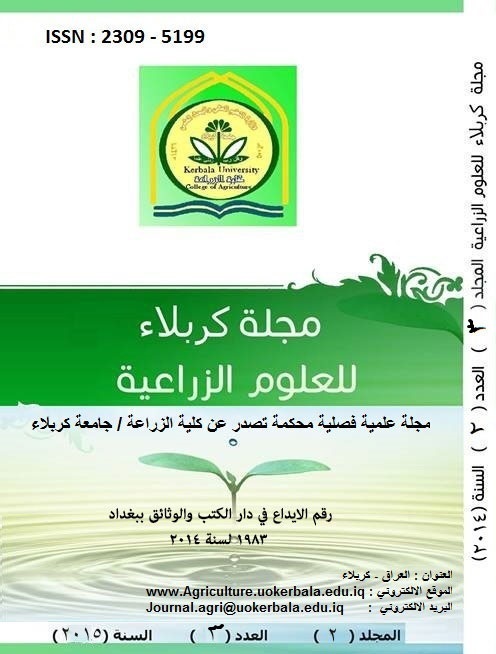The effect of two types of organic fertilizer ( plant and animal ) and the fungus Trichoderma harzianum on growth , yield and the severity of disease caused by the root-rot fungus Rhizoctonia solani Kühn on eggplant plant (Solanum melongena L.)
DOI:
https://doi.org/10.59658/jkas.v2i3.503Abstract
An experiment was carried out in aplastic house near the Technical institute of Al-Mussieb during the growing season 2012-2013 using eggplant (Solanum melongena L.) To study the effect of adding two kinds of decomposed organic fertilizers (animal ,plant and mixed 1:1) alone or with the Trichoderma harzianum fungus on growth , yield and severity of disease caused by the root-rot fungus Rhizoctonia solani on eggplant.
The study included eight treatments are added to the first T. harzianum fungus. to the second plant decomposed fertilizer, to the third plant added fer + T. harzianum fungi. To the fourth added animal fer ,to the fifth added animal fer. + T. harzianum fungi ,to sixth mixed plant and animal fer,to the seventh mixed plant and animal fer.+ T. harzianum fungi and the eight treatments leaves without any additions (compared). The complete CRBD with three replications was used and the means was compared by L.S.D test on 0.05%.
The result showed that the treatment of adding mixture of organic fer. with T. harzianum fungus had significant effect in improving all the parameter studied (length of vegetable shoot and root system of plant . number of branches \ plant ,wet weight of vegetable growth, dry weight of root and weight of yield) by104.66cm ,36.62cm, 7.10 branches \plant, 598.85 cm. 191.12 gm , 212.89 gm, 69.47gm and 4.02 ton. Donum-1, respectively in comparison treatment by 82.5%
The results also showed no difference between the treatment of adding animal fer. T. harzianum fungus in tall of vegetable growth, weight of wet vegetable, number of branch, weight of dry root and weight of yield by 94.4 cm , 533.8 gm, 6.8 branch \plant 64.81gm and 3.7 ton. Donum-1, respectively.
Downloads
Published
How to Cite
Issue
Section
License
Copyright (c) 2015 Copyright (c) 2024 is the Author's article. Published by the Journal of Kerbala for Agricultural Sciences under a CC BY 4.0 license

This work is licensed under a Creative Commons Attribution 4.0 International License.
Licensing Terms
All articles are published under a Creative Commons License and will be directed to the Creative Commons Attribution 4.0 International License (CC BY 4.0) That permits use, distribution, and reproduction in any medium, provided the original work is properly cited. This license also allows the work to be used for commercial purposes.
Use by both non-commercial and commercial users
This content is licensed under a Creative Commons Attribution 4.0 International (CC BY 4.0) license, permitting use by both non-commercial and commercial users. Individual users may access, download, copy, display, and redistribute the articles to colleagues, as well as adapt, translate, and text- and data-mine the content, subject to the following conditions:
- The author's moral rights, including the right of attribution and the right to protect their work from derogatory treatment, are respected.
- Where content in the article is identified as belonging to a third party, users must ensure that any reuse complies with the copyright policies of the owner of that content.
- If the article content is reused for research or educational purposes, users should maintain a link to the appropriate bibliographic citation, including the DOI and a link to the published version on the journal's website.

